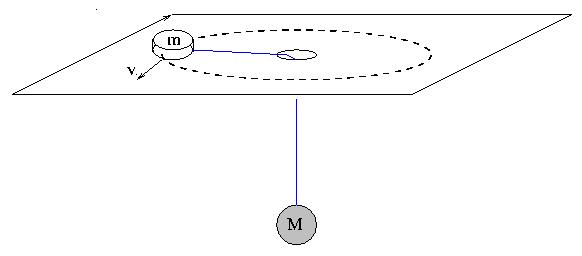
At time t=0, a force F starts to push the big block A. At the same time, the little block B is released.
How large must the force F be in order to keep the little block B from sliding down to the floor?
If the force is exactly this minimum required magnitude, how long will it take the blocks to slide 50 meters across the floor?

How fast must the puck be moving in order to keep the weight motionless?
Actually, the puck is moving at a different speed: it makes two revolutions every second. What is the puck's actual speed?
If the puck moves at this speed, is the weight M moving up or down?
What is the acceleration of the weight M?
A giant mutant gopher, hidden in his tunnel directly below you, begins to dig up towards the surface. The ground tilts slowly, so you are able to keep your balance and stand on your two feet ... but the ground becomes more and more vertical. At what angle will your feet start to slide along the asphalt?
What is the minimum coefficient of static friction between Tarzan's hands and the vine which allow him to hang (by one hand) on the vine?
Tarzan climbs the vine by pulling himself upwards with one hand at a time, while the other hand swings free. In a single motion, he pulls himself up a distance of 1 meter in a period of 0.8 seconds.
- Assume constant acceleration during this ascent. How hard must Tarzan grip the vine for friction to provide the needed upwards force?
- (if you have time) Assume that he accelerates for half the distance, then decelerates for the other half of the distance, so that his speed is zero when he has raised himself by 1 meter. What is the acceleration Tarzan needs during the first half of his motion? How hard must Tarzan grip the vine for friction to provide the upwards force this time?
Warning: this one takes some work ...
Joe Midway, a travelling carnival worker, is assigned the job of setting up "The Rotor" when the show arrives in Rochester. Just as in the sample problem, the ride has a radius of R = 2.1 meters. In this case, however, the coefficient of static friction between the walls and clothing is mu_s = 0.3.
Unfortunately, Joe has a bad hangover, and he makes two mistakes. First, he tilts the walls of the cylinder so that they tilt outwards at theta = 30 degrees from vertical. Second, he forgets to engage the device which limits the speed of the ride.
As a result, when the first batch of RIT students get on the ride, there is trouble. The cylinder starts to spin, getting faster and faster and FASTER. The ride is supposed to stop accelerating after the speed reaches 8 meters/second ... but this time it just keeps accelerating.
At what speed will the RIT students start to slide UP the walls?
 Copyright © Michael Richmond.
This work is licensed under a Creative Commons License.
Copyright © Michael Richmond.
This work is licensed under a Creative Commons License.